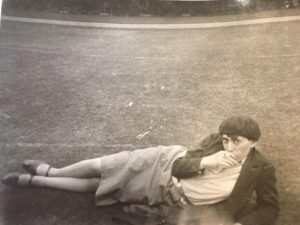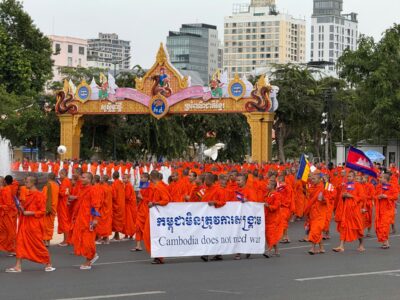Beyoncé has always been unafraid to sing about money. At just seventeen she sang of boyfriends borrowing her car and expecting her to keep the tank full (“Bills, Bills, Bills”), and at nineteen she raised that anthem of female financial autonomy, “Independent Woman.” Even after she had solidly risen to the heights of international stardom, Beyoncé’s lyrics still veered toward the power that came from her own hard-earned cash: “Yup, I put it on him, it ain’t nothing that I can’t do. Yup I buy my own if he deserve it buy his shit too” (“Countdown”).
 With Lemonade, all that money, all that power, all that independence, did not recede into the background (as if it was by this point obvious) but it got more pronounced, staggering now in scale. No longer a car she gives him a ride in but a helicopter. And the power is now global (“She’s stacking money money everywhere she goes, you know pesos out of Mexico”). It is now more than just the cash—her capital is part of something iconic, the stuff of legends. “Keep your money, I got my own—get a bigger smile on my face being alone. Bad motherfucker, God complex. Motivate your ass, call me Malcom X.” But the real difference in Lemonade is this unapologetic celebration of wealth woven into what critic Dee Locket calls a “new negro spiritual hymn.” Lemonade is an unambiguous indictment of police brutality and a hymn to African American empowerment. It is also a powerfully empathic piece of art, and takes a stand. The video portrays the mothers of Trayvon Martin, Eric Garner, and Michael Brown holding pictures of their sons. Hers is a voice that has profited mightily from capitalist America, but she stares right back at it and asks, “Is that all there is?” The question comes in the form of a stirring condemnation of the deadly powers in contemporary American society.
With Lemonade, all that money, all that power, all that independence, did not recede into the background (as if it was by this point obvious) but it got more pronounced, staggering now in scale. No longer a car she gives him a ride in but a helicopter. And the power is now global (“She’s stacking money money everywhere she goes, you know pesos out of Mexico”). It is now more than just the cash—her capital is part of something iconic, the stuff of legends. “Keep your money, I got my own—get a bigger smile on my face being alone. Bad motherfucker, God complex. Motivate your ass, call me Malcom X.” But the real difference in Lemonade is this unapologetic celebration of wealth woven into what critic Dee Locket calls a “new negro spiritual hymn.” Lemonade is an unambiguous indictment of police brutality and a hymn to African American empowerment. It is also a powerfully empathic piece of art, and takes a stand. The video portrays the mothers of Trayvon Martin, Eric Garner, and Michael Brown holding pictures of their sons. Hers is a voice that has profited mightily from capitalist America, but she stares right back at it and asks, “Is that all there is?” The question comes in the form of a stirring condemnation of the deadly powers in contemporary American society.
There is something profoundly counterintuitive about a vision of the world reveling in cash and also raising political consciousness. But in doing just this, it is almost as if Lemonade takes me right up to what Marilyn Robinson calls the “frontiers of the unsayable,” at least in the tradition I know best.
It is a tradition in which wealth, even pleasure, and especially women’s wealth, women’s pleasure, fits awkwardly with emancipatory politics. The particulars of the tradition come from a certain kind of Catholic counterculture, but they are shared in many intellectual and cultural traditions of the Left. In my world, Dorothy Day looms large. One of the many famous stories about Day describes an eager young woman who once asked her, “So do you see apparitions and visions?” “Hell no,” Day supposedly responded, “Only visions of unpaid bills.” (One might imagine someone creating a fabulous mashup between Day’s one-liners and Beyoncé’s lyrics.) In this tradition, men and women are steered toward the painful renunciation of the self in the image of the crucified Christ. “But daily, hourly, to give up our own possessions and especially to subordinate our own impulses and wishes to others—these are hard, hard things,” Day wrote, “and I don’t think they ever get any easier.”
Of course, in Catholicism (and everywhere), there are traditions that bless money, the making of it, the spending of it, and that also assure that its distribution is an expression of the laws of nature and of God. Catholic historian Thomas E. Woods spearheads an effort to align the economic policies of radical free-market principles of the far right with Church thinking. Sanctifying the status quo, these efforts symbolically raise the world’s money, just as it is, to the heights of the sacred. For this reason, a wealthy white man’s song about the bills in his wallet operates in an entirely different register than Beyoncé’s. It is somehow both embarrassing and dull. But we do care about her wallet. Hers is subversive, amassing wealth in a country that has blocked African American women’s access to it since the country’s founding. Her songs about money only become radical when situated within the context of ongoing racial disparities in “incarceration, education attainment, police brutality, hiring practices, access to health care, and, perhaps most starkly, wealth.” The context is more visible in Lemonade than any of her other albums because this one was, as Rembert Brown suggests, a “clear exercise in setting boundaries, in reminding everyone that we aren’t all the same. It’s a reminder, ‘I’m a woman, and I’m black, but also I’m a black woman—please don’t ever forget that[.]’”
It is this register of Lemonade that enabled me to see a set of sources I have been wrestling with in a totally new way. For years now, I have been researching a community of Catholic writers and activists who worked on the “utopian margins” of the mid-twentieth century. Two members of this community were women who were also fairly wealthy. Mary Kahil (1889–1979) was Syrian, and raised in Egypt in the Eastern Melkite tradition, a Catholicism indigenous to the Mideast. Marie-Madeleine Davy (1903–1998) was a French Catholic scholar of medieval mysticism and comparative religion. Just as Susan Sontag once described her own life, these women “pitched their tents outside the seductive safety” of universities and family life. They were intellectuals immersed in the political struggles of their era: Davy was active in the resistance to Nazism and Kahil was a leader of then-nascent feminist and anti-colonialist movements in Cairo. Later, Kahil led efforts to improve relations between Arabic Christians and Muslims. Neither Kahil nor Davy merely pointed out problems; instead, they evoked what they wanted in the world. They used their own considerable resources to summon living, breathing, alternative realities.
In 1923, when Kahil was thirty-five, she collaborated with other Egyptian women, some Muslim, some Christian, to cofound the Egyptian Feminist Union (EFU). It was no dour affair. Women activists used their own money to buy a building in Cairo to serve as the EFU headquarters and they held a two-day celebration inaugurating the occasion, where the famous singer Umm Kathum performed. In 1943, Kahil purchased an abandoned church building, had it re-consecrated, and built a center called Dar-es-Salam, which became an important hub for Muslim and Christian collaboration. She bankrolled it all. The utopian spaces of the EFU and Dar-es-Salam were only two in a long list of projects for which Kahil earned an Egyptian medal for humanitarianism in 1972.
 Marie-Madeleine Davy also had some of her own money, but she truly excelled at getting other people to give her even more and then doing extraordinary things with it. During the occupation of France, Davy convinced a wealthy family to loan her an entire chateau, called Fortelle, located just outside of Paris. Davy set up Fortelle as a place to hide clandestine resistance activity and hosted an influential salon. She convinced the wealthy banker and leftist Marcel Moré to fund much of the day-to-day operations. Years later, Davy also inherited a twenty-two-bedroom estate in the French countryside. She had another utopian dream for it: Davy turned the chalet into a summer dormitory to accommodate students from all over the world to forge international solidarities in the postwar era. She named the utopian experiment Maison Simone Weil, after her beloved friend who died too young.
Marie-Madeleine Davy also had some of her own money, but she truly excelled at getting other people to give her even more and then doing extraordinary things with it. During the occupation of France, Davy convinced a wealthy family to loan her an entire chateau, called Fortelle, located just outside of Paris. Davy set up Fortelle as a place to hide clandestine resistance activity and hosted an influential salon. She convinced the wealthy banker and leftist Marcel Moré to fund much of the day-to-day operations. Years later, Davy also inherited a twenty-two-bedroom estate in the French countryside. She had another utopian dream for it: Davy turned the chalet into a summer dormitory to accommodate students from all over the world to forge international solidarities in the postwar era. She named the utopian experiment Maison Simone Weil, after her beloved friend who died too young.
The eventual unraveling of Davy and Kahil’s utopian projects is another story. But while they were alive, they worked hard, made an impact, and threw themselves into their work. They sacrificed, but they also seemed to love it (“Oh, stars in her eyes, she fights and sweats those sleepless nights, but she don’t mind, she loves the grind . . .”). Kahil was also beautiful, drove a car, and spoke three languages. She loved Arabic music. She carried on a passionate, decades-long, sensual but not exactly sexual, friendship with the famous Islamicist Louis Massignon. People gossiped. For her part, Marie-Madeleine Davy once wrote that she spent her life trying to avoid the “professional deformation which converts the academic woman into something grey and correct and totally devoid of fantasy.” She drove a motorcycle and chain-smoked. Davy was big, dressed and owned her space like a man.
Suffering and voluntary poverty occupy a prominent presence in many traditions of the modern Catholic left, but in researching Kahil and Davy, these themes do not play much of a role in their religious imaginations. And for this, these women stand out. This is not to say their activism was without serious risk to their own lives: during the occupation, Davy was nearly arrested on several occasions and spent one twenty-four-hour period hiding in the basement of a bakery. (This book describes it and much more.) But both Davy and Kahil seemed to truly relish the pleasures of this world just as they fought against the powers that limited them for most people. They help us push back on our expectation that people’s lives revolve around one thing. They embodied dissident ways of being in the world.
For some people in this world, the display of health, of pleasure, of joy—accompanied by bold commitment to emancipatory politics—is itself a radical act. Kahil and Davy pushed back against the massive weight of the tradition that would point them, dourly, to the way of the cross. I think of Maggie Nelson’s notion of the radical possibilities of pleasure that can become “accretive as well as auotelic: the more it’s felt and displayed, the more proliferative, the more possible, the more habitual it becomes.” Kahil and Davy used their money—the cash they made, the cash they inherited, the cash they convinced others to give them—to conjure new answers to the question “Is that all there is?”
We might think that their commitments to pleasures and politics would signal lives exclusively committed to the immanent frame. And it is true that for Kahil and Davy, as for so many others in their world, secular modernity had darkened a landscape that they imagined had once, in earlier eras, glowed bright with the lights of the sacred. Not much of the supernatural glowed from Rome (Davy called the Vatican the “grave digger of the holy”). But neither imagined that the lights of transcendence had gone out, yielding to a monochromatic immanent frame of secularism. Neither did they imagine that holiness was simply now found within, tucked inside their own souls. Davy and Kahil gravitated toward the old embers whereby people saw flickers of something of God in other human beings of flesh and bone, and that holiness was something contagious, spread between people.
They both remained single all their lives, but they each had intense spiritual friendships, with both men and women. It was in the context of these friendships that God was made real for them. Kahil once confessed to Massignon, “I do not know how to pray alone, it is only in writing you, and in my journal, that I put myself in God’s presence.” God came to Davy through the intimacy and resilience of invisible friendship in the form of her memories of Simone Weil. “No one of our age,” she wrote, “has created such an intensity of spiritual radiance as Weil.” She carried within herself a “flame” that “scorched others.” “God hides in secret places,” Davy wrote, reminiscing. The love and holiness they experienced in these friendships fueled their utopian political projects (it was the “radiating center” of her work, Kahil said). And their money helped materially enact it. Just as Beyoncé framed her lyrics about marriage within the broader narrative of generations of assault on the black American family, their stories refuse the banishment of love, intimacy, and God into the private sphere.
One of the enduring contributions of The Immanent Frame has been to advance the effort to think our way out of what Janet Jakobsen and Ann Pellegrini call the “complacent consensus” of secularism, its promise of an inevitable moral and political advance. Attention to women like Kahil and Davy helps shake off familiar habits of thinking. Women, along with religion, have long been relegated (in Tracy Fessenden’s words) as “capitalism’s salvific counterpart: pious . . . sealed from the energies of the market.” The story of these women’s own wealth circulating on the utopian margins of religion is a defiant flight from these old assumptions.
In so many ways, our world right now is utterly nightmarish. But we are also in the midst of an extraordinary renaissance in music, art, and journalism, thanks to artists and writers whose works are powerful enough to fundamentally change our sensibilities in the present. Lemonade is one of those albums that appears and the world suddenly looks different. For historians of religion, the world we most often reach for is the world of the past. When we reach back into the vast immensity of our sources, we make a few selections, but eliminate most of it. We must. Friedrich Nietzsche was right in that the thinking person requires forgetting most things, and our forgetting should be a process as active as possible, a conscious and liberating willingness to move on. But too often we tend to make our decisions about the past passively, by relying on old habits of thought that tell us what is radical, inspiring, intriguing, worth retrieving. Sometimes something changes our present-perception so profoundly that we suddenly look back with new eyes, and fresh images come into focus. The extravagant example of Lemonade did this for me.














Fascinating piece, Brenna!